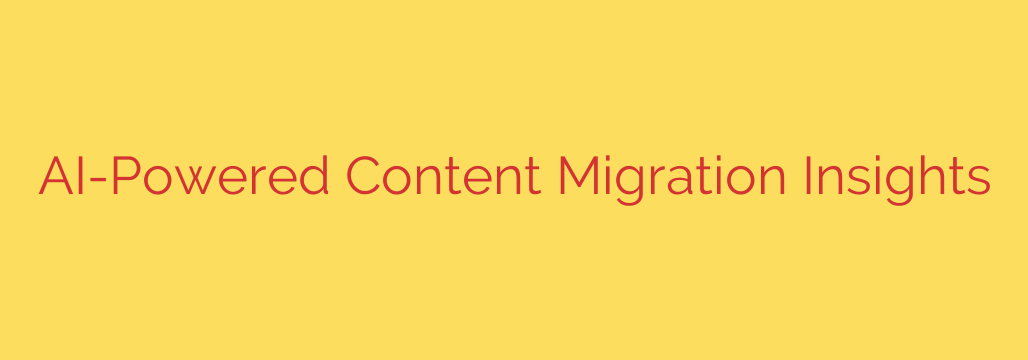
Smarter, Faster, Safer: How AI is Transforming Content Migration
Content migration is often seen as a necessary evil—a complex, time-consuming, and risk-fraught process that businesses must endure when upgrading systems or moving to the cloud. The traditional approach involves massive manual effort, leading to budget overruns, missed deadlines, and critical errors. However, the integration of Artificial Intelligence (AI) is fundamentally changing this landscape, turning a dreaded task into a strategic opportunity for enhanced data governance and business intelligence.
By moving beyond simple “lift and shift” operations, AI introduces a layer of intelligence that automates, analyzes, and secures content throughout the migration lifecycle.
The Traditional Headaches of Content Migration
For years, migrating content from one system to another—be it an old intranet, a shared drive, or a legacy Content Management System (CMS)—has been plagued by persistent challenges. These projects are notorious for:
- Intense Manual Labor: Teams spend countless hours manually sorting, tagging, and moving files, a process that is both inefficient and unscalable.
- High Risk of Human Error: Manual handling inevitably leads to mistakes, such as broken links, misclassified documents, and incorrect metadata application, which undermines the usability of the new system from day one.
- Security and Compliance Gaps: Sensitive data, such as personally identifiable information (PII) or confidential corporate documents, can be inadvertently exposed or mishandled during a manual transfer, creating significant compliance risks.
- Migrating Clutter: Without an intelligent way to sort content, businesses often migrate redundant, obsolete, and trivial (ROT) data, bloating storage costs and cluttering the new environment.
AI-powered migration directly addresses these pain points by replacing manual guesswork with data-driven precision.
The AI Difference: More Than Just Moving Files
An AI-driven approach transforms content migration from a simple relocation project into an intelligent reorganization of your digital assets. Here’s how AI makes the process smarter and more effective.
Intelligent Automation and Classification
Instead of relying on folder names or file types, AI algorithms analyze the actual content within your documents. Using Natural Language Processing (NLP), the technology can understand context, identify key themes, and automatically apply relevant metadata and tags.
This means a contract can be automatically identified and tagged with the client’s name, key dates, and contract value. This intelligent classification ensures that content is not just moved, but is made significantly more organized and searchable in its new home, unlocking its value for a wider audience.
Proactive Data Security and PII Detection
One of the most powerful applications of AI in migration is its ability to enhance security. AI-powered tools can intelligently scan documents during the migration process to identify and flag personally identifiable information (PII), financial data, intellectual property, or other sensitive content.
This allows organizations to take immediate action, such as redacting sensitive information, applying stricter access controls, or quarantining specific files for review. This proactive approach to data governance is crucial for meeting compliance standards like GDPR and CCPA and is nearly impossible to achieve at scale with manual methods alone.
Eliminating Redundant and Obsolete Content (ROT)
Why pay to move and store useless data? AI excels at identifying ROT data by analyzing file duplicates, version histories, and usage patterns. It can pinpoint documents that are redundant, outdated, or trivial, allowing you to confidently archive or delete them before the migration begins. This not only reduces migration time and storage costs but also ensures your new system launches with a clean, relevant, and high-value content repository.
The Tangible Benefits of an AI-Powered Strategy
Adopting an AI-first mindset for content migration delivers clear, measurable advantages that extend far beyond the project’s completion.
- Drastic Reduction in Time and Cost: By automating the most labor-intensive tasks, AI reduces project timelines from months to weeks, resulting in significant cost savings on labor and resources.
- Greatly Improved Accuracy: Automation minimizes the risk of human error, ensuring that metadata is applied consistently and links remain intact. This leads to a more reliable and user-friendly destination platform.
- Enhanced Security and Compliance: With automated PII detection and classification, you achieve a level of proactive risk management that is simply unattainable through manual checks.
- Future-Proofs Your Content: By enriching your content with high-quality metadata upon arrival, you make it more discoverable and valuable for future applications, including advanced analytics, eDiscovery, and other AI-driven tools.
Actionable Steps for a Successful AI Migration
To leverage the full potential of AI in your next content migration, follow these key steps:
- Define Clear Goals: Start by identifying what you want to achieve. Is the primary goal to improve searchability, enforce data security policies, or simply reduce clutter? Your objectives will guide your AI strategy.
- Conduct a Content Audit: Use AI tools to perform an initial analysis of your source content. This will provide critical insights into ROT data, the location of sensitive information, and the overall health of your current repository.
- Develop a Smart Taxonomy: Before the migration, design the metadata structure and classification schema you want in the new system. AI can then be trained to automatically apply this taxonomy during the migration process.
- Run a Pilot Project: Test the process with a smaller, representative subset of your content. This allows you to fine-tune the AI models and validation rules before committing to the full-scale migration.
- Validate and Iterate: After the content is moved, use automated checks to validate the migration’s success. Ensure metadata is correct, permissions are properly set, and there are no broken links.
In conclusion, AI is no longer a futuristic concept in the world of data management—it is a practical and powerful solution to the age-old problem of content migration. By embracing an intelligent approach, organizations can execute migrations faster, more securely, and with greater accuracy, ultimately transforming their digital assets into a well-organized and highly valuable business resource.
Source: https://feedpress.me/link/23532/17173688/lessons-from-an-ai-assisted-content-migration








